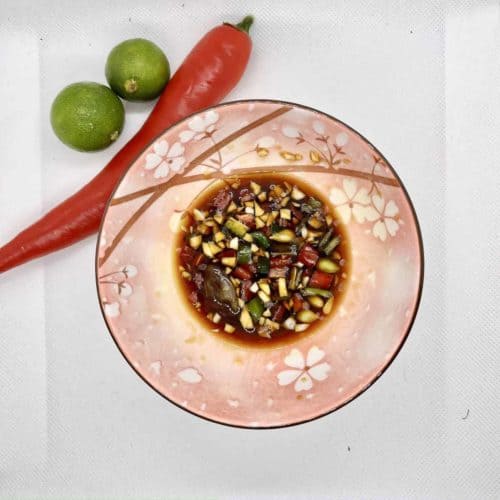A guide to fish sauce vs soy sauce: how to use them in Asian cooking, the similarities, differences, and substitutes.

Jump to:
In Asian Cuisine
In Asian cuisine, there are a few basic sauces that can be found in almost every kitchen. There's oyster sauce, light soy sauce, dark soy sauce, sweet soy sauce (kecap manis), and fish sauce, to name a few. (The soy sauce we're referring to in this article is the most common one: light soy sauce.)
Each of these centuries-old liquid condiments brings a unique savory flavor to the table The fermentation process, whether of soybeans for that rich, salty liquid known as soy sauce or of small fish and salt to give us pungent fish sauce, underscores the diverse culinary landscape of Asia.
Both add a umami flavor to recipes: Light Soy Sauce tends to be more widely used: you'll see variations of it in Chinese cooking, Japanese food, Korean cuisine (mayak avocado, soy sauce eggs etc), Indonesian recipes, and more.
Fish sauce is more common in Thai cooking, Southeast Asia, and Korea. It is not as common in China, where it is native to Guangdong and Fujian in the South.)
Both sauces are similar in that: they are Asian sauces, made by fermentation, with a strong umami flavor.
Differences
We'll look at some of the most obvious differences between fish sauce and soy sauce, before going on to explore their production, culinary uses, storage, and substitutes in more detail.
- Appearance: both are brown, thin liquids, but soy sauce is a little darker in color.
- Taste: both are salty, but soy sauce can be a little sweet, whilst fish sauce has a brininess similar to anchovies.
- Smell: Soy Sauce smells more innocuous: deep and savory. Fish sauce has a brininess and almost fishiness that those new to Asian cooking may find overpowering.
- Ingredients: Soy sauce is made from soy beans and wheat, whilst fish sauce is made from, well, fish and thus contains animal ingredients.
- In theory, fish sauce is gluten-free but not vegan whilst soy sauce is vegan but not gluten-free. However, manufacturers sometimes add other ingredients, so always check the labelling.
- Cuisines: Fish sauce is associated with Thailand and Southeast Asia, whilst soy sauce is used widely everywhere from China to Japan.
Fermentation/ Production
Soy sauce and fish sauce have uniquely different origins, yet they both capture the essence of umami.
Soy Sauce
They rely on the fermentation process over a long time to develop their distinctive flavors. For soy sauce, soy beans are the star, undergoing a long-time fermentation with what to break down proteins into savory amino acids. This process imparts a depth of flavor that enhances Asian cooking in a myriad of ways.
Fish Sauce
Fish sauce boasts a simpler ingredient list of small fish or shrimp and salt water. These components ferment for months, sometimes years, to yield a salty liquid rich in fishy flavor and amino acids, crucial for Thai cuisine and Southeast Asian cuisine.
The basic production process is as follows:
- catch the small fish
- salt them
- ferment them
- extract the sauce: the first extraction is called the first press.
Soy sauce and fish sauce have different ingredients. Soy Sauce contains wheat, so is not gluten-free. For fish sauce, it depends: some brands are gluten-free whilst others are not, so check the labelling. (Wheat is not a traditional ingredient in fish sauce, but some companies use it.)
Culinary Uses
Fish sauce and soy sauce are both versatile condiments that finds their way into countless marinades, stews, dipping sauce, salad dressings, and stir fries, delivering a rich, nuanced taste to Asian food.
Soy Sauce

Fish Sauce

Asian fish sauce goes very well with lime juice. The most classic use of fish sauce is in pad thai.
Since it's such a staple in Southeast Asia, it's often paired with coconut milk, sambal, and more.
Storage
Both fish and soy sauce do not need to be refrigerated after opening. Store in a cool, dry and dark place.
Substitutes: Adapting for Allergy and Diet
Adhering to a vegan diet or managing a fish allergy does not mean you need to miss out on the complex flavors of Asian cuisine. Excellent substitutes exist!
Soy Sauce Alternatives

If you need a gluten-free replacement for soy sauce,
- Coconut aminos serve as a fantastic stand-in with their slightly sweet, savory profile. They offer a complexity akin to traditional soy sauce but without the soy or fish products, catering to those avoiding soy beans or fish sauce.
- Another option is Japanese tamari.
- For more light soy sauce substitutes, click here.
Fish Sauce Substitutes
Personally, I've never found a good fish sauce substitute that can add the same brininess and umami:
- I guess soy sauce/ tamari/ coconut aminos and sea salt can be used, but the resulting dish won't be quite the same. I'd only recommend it if you're serving someone with a fish allergy. (I also plan to experiment with mixing soy sauce with anchovies.)
- Worcestershire sauce actually contains anchovies, so some use it as an alternative. However, it's much too tangy to be a good replacement.
- Some people suggest using a kelp-mushroom soy sauce as a vegan fish sauce- I've tested it, but it tests NOTHING like fish sauce.
Frequently Asked Questions
For generic cooking, a good choice is Thai Squid Brand fish sauce. When I want to splash out, I use Vietnamese Red Boat (very pricey as it's first press sauce.)
Lee Kum Kee is one of the most commonly used brands, which I use for everyday cooking. I also keep a bottle of soy sauce that has been naturally fermented for over 12 months, for important dinners. (I use the Singaporean Nanyang and Kwong Woh Hing brands.)
Fish sauce has been fermented, so it can keep for ages if stored properly. However, throw it out if the smell changes, or if you see mold. (Salt sometimes crystallizes at the bottom or the mouth of the fish sauce bottle- it is still good to use!)
If your recipe does not state how much fish sauce to use, keep in mind that this liquid condiment is very salty. Add it sparingly, tasting as you go.
It varies from brand to brand. Some are and some aren't so always check the label.
For more information on soy sauce vs fish sauce, let me know in the comments!

















Comments
No Comments